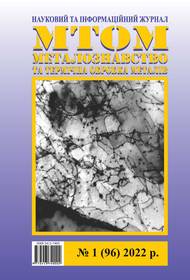INFLUENCE OF INTERNAL FACTORS ON THE MECHANICAL PROPERTIES OF METALS AND ALLOYS
DOI:
https://doi.org/10.30838/J.PMHTM.2413.240422.57.844Keywords:
internal factors, structural condition, macrostructure, non-metallic inclusions, loading, plastic deformation, fracture resistance, mechanical anisotropyAbstract
Purpose of research. Development of a methods for the internal factors complex influence on obtaining the required properties of metal products. To show, using the example of macrostructure, that not only the quantitative but also the qualitative nature of change impact in the studied internal factor can vary markedly, depending on the constant values level of the other internal factors. Methodology. The use of influencing various factors methods on the complex of mechanical properties required in these conditions for metal products. Analytical method of the data array analyses for the dependence of mechanical properties on internal factors according to literature sources and data obtained by the authors of the article. Results. Method of various internal factors selecting to obtain the required mechanical properties of various products. It is shown that the parameters of structural state are connected with the type and nature of substance atoms distribution in three types of object internal space simultaneously: geometrical, energetic and chemical (concentration). Scientific novelty. Information on the mechanical properties of the object, which is realized as specific reactions to external influences. Information on possible transformations of the object structural state by way of phase and structural transformations under specific energy-information impact. At the same time, the developed method necessarily includes consideration of the structural complexity level in order to obtain the specified mechanical properties of the metal products. Practical significance. Using the developed metod to improve the operational reliability of metal products during their operation. It is shown that the “dimensional” interpretation of the macrostructure does not reflect one of its main properties related to the origin (genesis): the practical absence of the heat treatment impact on the critical majority of macrostructure parameters. For practical applications, it is shown that macrostructure parameters have a significant influence on ductility and resistance to both ductile and brittle fracture. As the contamination index Ic increases, the ductility and fracture resistance characteristics decrease. The intensity of the fall in these properties at the same values of Ic is significantly depended on the characteristics values of the most non-metallic inclusions listed above. So, the negative impact of this macrostructure parameter on plasticity and resistance to fracture increases with the transition from globular form inclusions to nonequilibrium form inclusions, with increasing curvature of the surface of the section “inclusions – matrix”, from plastic, deformed inclusions to brittle and undeformed inclusions.

Downloads
Published
Issue
Section
License
Authors that are published in this journal agree to follow the conditions:
Authors reserve the right to the authorship of his work and cede the right to the journal of first publication of this work on conditions of the license under the Creative Commons Attribution License, which allows others to distribute it freely with the obligatory reference to the author of the original work and the first publication of the work in this journal.
